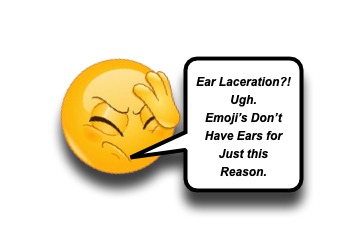Originally published at Pediatric EM Morsels on April 5, 2019. Reposted with permission.
Follow Dr. Sean M. Fox on twitter @PedEMMorsels
Lacerations and injuries are pervasive in the Pediatric ED. While lacerations on the arms and legs deserve consideration (at least consideration of whehter they need tetanus prevention?), facial lacerations will often attract a lot of attention. We have discussed other important lacerations previously (ex, Eyelid laceration, Tongue Laceration), but let us consider another prominent structure on the face – External Ear Lacerations:
External Ear Anatomy
- The external ear is the pinna or auricle and includes the: [Eagles, 2013; Falcon-Chevere, 2013]
- Helix and antihelix,
- Tragus and antitragus,
- Concha, and
- Lobule.
- Arterial blood supply: [Eagles, 2013; Falcon-Chevere, 2013]
- Posterior Auricular Artery
- Superficial Temporal Artery
- Innervated by: [Eagles, 2013; Falcon-Chevere, 2013]
- Auriculotemporal Nerve
- Auricular branch of the Vagus Nerve
- Greater Auricular Nerve
External Ear Lacerations: Basic Concepts
- Can be difficult to repairdue to: [Eagles, 2013; Davidson, 1994]
- Geography of the auricle and orientation of laceration
- Thin overlying skin
- While there is great blood supply, the thin skin and delicate cartilage can have blood supply compromised
- Priorities for Repair include: [Falcon-Chevere, 2013]
- Cosmetic re-approximationof wound edges
- Complete coverage of exposed cartilage
- Preservation of skin
- Prevention of complications
External Ear Lacerations: Repair Considerations
- Don’t do things you are not comfortable doing (generally good advice across the board).
- There are no hard/fast rules as to which lacerations “mandate” consultation with specialist.
- Referral resources and the relationship you have with them vary drastically from Department to Department and from region to region.
- Some more challenging cases that are prone to have complications include: [Eagles, 2013]
- Lacerations > 3 cm (may require grafting)
- Large V-Shaped laceration (can have lots of tension, which can compromise blood supply).
- Near and complete ear avulsions(obviously)
- Don’t overlook the other injuries! [Sabatino, 2013; Falcon-Chevere, 2013]
- Look for TM rupture
- Look for signs of skull fractures
- Assess Cerivical Spine
- Be kind! (as always)
- An auricular field blockwill be more beneficial than local infiltration.
- Local infiltration will distort important anatomy.
- Field block will last longer.
- Anxiolysis, analgesia, and/or full sedationmay be required.
- An auricular field blockwill be more beneficial than local infiltration.
- Clean and Irrigate (always important!)
- Repair
- Most lacerations of the helical rim that are < 2 cm can be repaired with primary closure. [Eagles, 2013]
- See [Childs, 1997] for diagram of closure technique for earlobe laceration.
- First approximate the anatomic areas and landmarksof the ear. [Falcon-Chevere, 2013]
- Use as few sutures as possible.
- If suturing the cartilage, be gentle, as it tears easily. [Falcon-Chevere, 2013]
- 4-0 and 5-0 absorbablesutures to approximate cartilage.
- Include the anterior and posterior perichondrium.
- Most lacerations do NOT require closure of the cartilage specifically, as long as closure of the skin approximates edges of cartilage. [Sabatino, 2013]
- Skin closure with 5-0 to 6-0 nonabsorbable synthetic suturesinsimple interrupted fashion.[Sabatino, 2013; Falcon-Chevere, 2013]
- Dress withCompression dressing to help avoid hematoma formation. [Falcon-Chevere, 2013]
- Antibiotics:
- Utility is Debated. [Kelly, 2012]
- Consider if cartilage is involved, wound was dirty, or other infectious concerns (ex, patient has diabetes). [Falcon-Chevere, 2013]
- If antibiotics are used, consider coverage for pseudomonas, especially if laceration is related to an ear piercing. [Kelly, 2012]
External Ear Lacerations: Complications
- As with all facial lacerations, there can be a lot of blood loss.
- Failure to cover cartilage resulting in: [Eagles, 2013]
- Chondritis
- Ear Deformities
- Auricular Hematoma
Moral of the Morsel
- Know what you are comfortable with… but, most ear lacerations can be closed by carefully re-approximating the skin.
- Keep ‘em comfortable! Use a region field block!
- Get comfortable with tiny sutures! 5-0 and 6-0 is the way to go!
References
Forsch RT1, Little SH1, Williams C2. Laceration Repair: A Practical Approach. Am Fam Physician. 2017 May 15;95(10):628-636. PMID: 28671402. [PubMed] [Read by QxMD]
Kolodzynski MN1, Kon M2, Egger S2, Breugem CC3. Mechanisms of ear trauma and reconstructive techniques in 105 consecutive patients. Eur Arch Otorhinolaryngol. 2017 Feb;274(2):723-728. PMID: 27714497. [PubMed] [Read by QxMD]
Sabatino F1, Moskovitz JB. Facial wound management. Emerg Med Clin North Am. 2013 May;31(2):529-38. PMID: 23601487. [PubMed] [Read by QxMD]
Falcon-Chevere JL1, Giraldez L, Rivera-Rivera JO, Suero-Salvador T. Critical ENT skills and procedures in the emergency department. Emerg Med Clin North Am. 2013 Feb;31(1):29-58. PMID: 23200328. [PubMed] [Read by QxMD]
Eagles K1, Fralich L, Stevenson JH. Ear trauma. Clin Sports Med. 2013 Apr;32(2):303-16. PMID: 23522511. [PubMed] [Read by QxMD]
Kelly H1. BET 2: no evidence for prophylactic antibiotics in pinna laceration. Emerg Med J. 2012 Sep;29(9):777. PMID: 22903426. [PubMed] [Read by QxMD]
Brown DJ1, Jaffe JE, Henson JK. Advanced laceration management. Emerg Med Clin North Am. 2007 Feb;25(1):83-99. PMID: 17400074. [PubMed] [Read by QxMD]
Childs C. Practice tips. Repair of lacerated earlobes. Can Fam Physician. 1997 Jan;43:39. PMID: 9626422. [PubMed] [Read by QxMD]
Davidson TM, Neuman TR. Managing Ear Trauma. Phys Sportsmed. 1994 Jul;22(7):27-32. PMID: 29283710. [PubMed] [Read by QxMD]










1 thought on “External Ear Lacerations”
I routinely repair small lacerations with skin glue. Excellent cosmetic result and doesn’t require sedation.